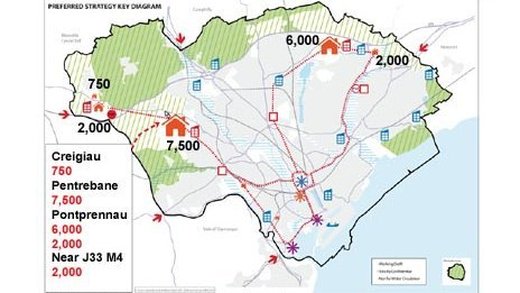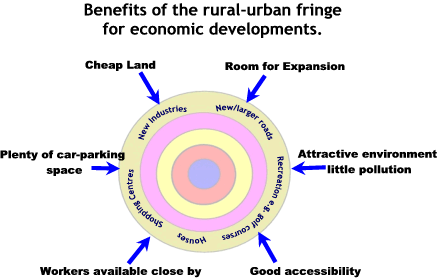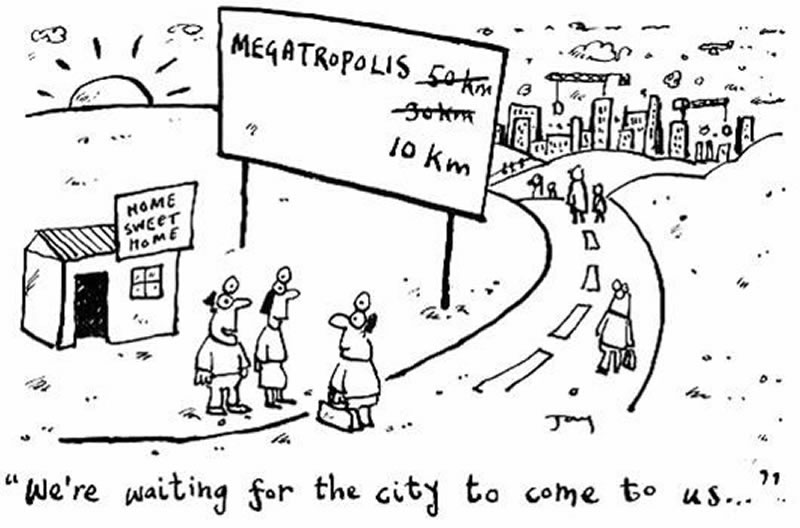Monday 21 January 2013 - SDME
Back Yard Syndrome - Why could the building of key settlements in rural areas be controversial?
The Background Information
|
Objective: To find out why we need to build new houses in the UK and why rural areas are being considered.
The situation in 2012 i. 2/3 of English men in their 20's and 30's still live with their parents! Ouch. ii. There are around 230,000 new households created in England every year. iii. The population is rising due to birth rates and net migration levels. iv. There are not enough affordable homes for buyers in the UK. Task 1 - Make a note of the key issues above and watch the Sky News video to the top right too. Task 2 - Read this BBC News article about the shortage of housing in England. You might want to listen to the BBC Radio 4 (sorry not Radio 1!) programme embedded into the page too. Take notes on the key problems and issues being faced. The opposition to rural building Task 3 - Watch the video to the right and note down why local people in the Nottingham area are so angry. Always two sides to the story. Task 4 - Create a table in your books with two columns. The first column should be entitled 'Benefits of Building in Rural Areas' and the second 'Drawbacks of Building in Rural Areas' Read this BBC news article and identify as many benefits and drawbacks as possible. |
Situation in Nottingham, UK.Task 5 - Complete the DME by clicking the link underneath.
|
BBC Learning ZoneVideo 1
Over recent decades the previously rural landscape of East Anglia has been transformed by the introduction of new towns and improvements in transport. A post-war animation illustrates the threat of urban sprawl. Green belts were set up to contain cities with new towns being established in outlying rural areas. Archive footage from the 1950s shows new towns being built in East Anglia, e.g. Harlow, Peterborough, Stevenage and Basildon. The commentary describes the key features of a new town, emphasising the promise of a bright new future. Increased car ownership and motorway construction have encouraged further growth by opening up the rural landscape, influencing previously rural house prices. Video 2 Planners and developers are returning to the concept of new towns, first introduced in the 1950s, in an attempt to address demand for housing in East Anglia.. Includes aerial shots of Cambourne, a modern new town in Cambridgeshire, with archive footage drawing comparisons with the original new towns such as Harlow. The project director explains the plans for Cambourne were based on old English settlements to promote more rural lifestyles. An extra half a million people are expected to move to East Anglia in the next decade. This will require extra investment in housing, and further new towns like Cambourne are already in the pipeline Video 3 The new town of Cambourne in Cambridgeshire has been built since 1998 to meet the need for new housing in East Anglia. Aerial shots of Cambourne and an animation show the transformation which has occurred since 1998. Cambourne was designed to replicate English village life, a point emphasised by the project director who talks of the range of facilities and employment opportunities on offer. Concludes with a short section outlining the controversy surrounding modern 'eco towns' |
|
The Rural Urban FringeStudy the embedded presentation to the right hand side and make notes on the issues and controversy surrounding the urban rural fringe.
You should include a definition of the RUF too and be prepared to remember it for your exam in January. Objective: To understand the basic issues surrounding building settlements in rural areas and green belt areas.
The two types of land available for building can be broadly split into two types: 1. Greenfield Land 2. Brownfield Land Task 1 - Click here to be taken to the GCSE Geography Bitesize link to find out more. Make notes on both different types of site. Task 2 - Read this BBC News article from Cardiff about proposed expansion of housing and services in and around the city. Make sure that you read the comments at the bottom of the article too. They reflect people and their views on the expansion project. Make notes on the themes explored in the article: Social - Positive & Negative Economic - Positive & Negative Environmental - Positive & Negative Task 3 - Test yourself on a paper from 2009 below. |
|
The Green BeltDefinition: Countryside area around an urban area which are protected from development to restrict urban sprawl
To restrict development on greenfield sites (sites that have not previously been built on), urban sprawl has been constrained by the creation of Green Belts. Green Belts were created in 1947 as 'collars of land' around urban areas where development is severely restricted to preserve the character of the environment. Whilst green belts have successfully slowed urban sprawl, in some cases they may protect land of little value, whilst development 'leap-frogs' the constraints of the green belt and begins to grow on the higher quality land beyond it. Wedges of protected land, as opposed to a surrounding 'collar' have been suggested as a way of allowing controlled growth, whilst protecting high-quality land. Indeed the debate about the future of greenbelts has increased and campaigners are trying to protect greenbelt land. There are concerns in a number of areas, as further urban development threatens the existing Green Belts. For example, countryside around both Stevenage and Cambridge is under threat due to plans for the development of new homes, whilst other areas are under threat from other types of development, including plans for a park and ride scheme on the edge of Cambridge Why build on Brownfield Sites? - many areas have unoccupied houses which could be upgraded - brownfield sites already have utilities such as water and gas pipes - development in urban as opposed to rural areas can help reduce reliance on cars Why build on Greenfield Sites? - cheaper to build on (don't have demolition costs) and lower land-values than in urban areas - generally perceived as better quality of life in the countryside Source: GeoBytes & Mr Chambers |
Your browser does not support viewing this document. Click here to download the document.
Previous Sample ExamsThe booklet has now been released and scroll down to the next section to download.
To give you as much practice as possible, I have included a example from the year 2000 which has a similar focus to your upcoming January 2013 paper. Have a go at the exam below: |
Your browser does not support viewing this document. Click here to download the document.
|
SDME Booklet 21 January 2013Released on Monday November 19th on the OCR website - Public Access. Download the three large files to the right hand side from the OCR public access website. This might take some time.
|
Great job by Mr Berry ... thanks
The 21-01-13 SDME Location - Leicester Airport
**Great for those of your studying in or around Leicester!
Study the embedded Google Map beneath to familiarise youself with the area.
|
Ecotowns Video Above - Starts in Leicester. Well worth watching to set the scene. Then complete the activity below. Thanks to Ro McGrath
|
Task - Click on this link to read about an eco-town scheme in Leicester. Outline the arguments for and against this scheme and identify the key stakeholders. (Thanks to Kate
Vaughan, Teacher @ Sunbury Manor)
SDME 21-01-13 Focused PreparationIf you are sitting this exam, many of your teachers have been hard at work devising together preparation booklets and sample questions to help you to understand the exam and prepare you for the exam. These are great resources and should really help you out.
SDME Preparation Booklet by Richard Briggs SDME Mock Questions by Ro McGrath and Damian Gray (OCR Ning) (OCR Ning) |
How will the exam work?
Objective: To understand how the exam is going to be structured, the types of questions and to get our timings right for each section.
There will be three sections to complete, A, B & C
Section A - The Background
Normally worth 10 marks and split into three or four questions worth between 1 to 5marks per question. You should spend no more than 15 minutes on this section.
This will test you on your ability to interpret data from the resource booklet (probably the first two or three resources in the booklet). Expect 'describe' and 'explain' type questions and be prepared to comment on sustainability e.g.
Example Question: (Click here for a mock exam created by Max Rayner - 15/01/2013)
Question 1 - Using resources 1a & 1b, describe the pattern of the future urban and rural populations using data from the booklet.
Question 2 - Using resource 2, explain the drop in percentage of population aged 16-29 living in rural areas.
Question 3 - Using resource 2, explain the increase in the percentage of population aged 65+ living in the countryside.
Section B - The Opinions.
Normally worth 14 marks and the questions are more complex. Expect two or three questions worth between 5 to 8 marks each. You should spend no more than 20 minutes on this section.
This year, there are no stakeholders mentioned explicitly although you may want to pick them out of the newspaper article in Resource 3.
There follows lots of information on sustainable settlements and so there will perhaps be some focused questions looking at the different aspects of settlement sustainability and who would benefit from this.
Expect questions that ask you to comment on the different sustainability aspect of S.E.E (Social, Economic, Environmental) related to the stakeholders (people involved) and the location (near Leicester, UK)
Example Question: Not known until the SDME booklet is released.
Section C - The Decision
Normally worth 16 marks and you have one decision to make that could take up to two pages two write about. You need to spend the final 25 minutes on this section. It is really important that you don't overrun on the previous two sections as you will not have enough time to get excellent marks here unless you have enough time. Watch that clock!
Example Scenario from the booklet:
1- build an entire ecotown on the whole area
2- build a smaller settlement on the site of the airport only
3- build on existing space (brownfield sites) in existing towns and cities
There will be three sections to complete, A, B & C
Section A - The Background
Normally worth 10 marks and split into three or four questions worth between 1 to 5marks per question. You should spend no more than 15 minutes on this section.
This will test you on your ability to interpret data from the resource booklet (probably the first two or three resources in the booklet). Expect 'describe' and 'explain' type questions and be prepared to comment on sustainability e.g.
Example Question: (Click here for a mock exam created by Max Rayner - 15/01/2013)
Question 1 - Using resources 1a & 1b, describe the pattern of the future urban and rural populations using data from the booklet.
Question 2 - Using resource 2, explain the drop in percentage of population aged 16-29 living in rural areas.
Question 3 - Using resource 2, explain the increase in the percentage of population aged 65+ living in the countryside.
Section B - The Opinions.
Normally worth 14 marks and the questions are more complex. Expect two or three questions worth between 5 to 8 marks each. You should spend no more than 20 minutes on this section.
This year, there are no stakeholders mentioned explicitly although you may want to pick them out of the newspaper article in Resource 3.
There follows lots of information on sustainable settlements and so there will perhaps be some focused questions looking at the different aspects of settlement sustainability and who would benefit from this.
Expect questions that ask you to comment on the different sustainability aspect of S.E.E (Social, Economic, Environmental) related to the stakeholders (people involved) and the location (near Leicester, UK)
Example Question: Not known until the SDME booklet is released.
Section C - The Decision
Normally worth 16 marks and you have one decision to make that could take up to two pages two write about. You need to spend the final 25 minutes on this section. It is really important that you don't overrun on the previous two sections as you will not have enough time to get excellent marks here unless you have enough time. Watch that clock!
Example Scenario from the booklet:
1- build an entire ecotown on the whole area
2- build a smaller settlement on the site of the airport only
3- build on existing space (brownfield sites) in existing towns and cities
Mock Exams Based on 2013 Booklet - Thanks to Mr Hayes
Mock Exams Based on 2013 Booklet - Thanks to Ms Burgess
|
|
|








